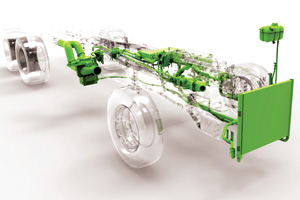Efficiency Goals Set for Tractors, Engines, Trailers

The federal government has issued its long-awaited proposal to further tighten greenhouse-gas emissions from heavy- and medium-duty trucks, and for the first time regulate trailer efficiency.
The June 19 joint proposal from the Environmental Protection Agency and the National Highway Traffic Safety Administration would phase in increasingly stringent standards for new trucks in 2021, 2024 and 2027 — targets that would be achieved through incremental improvements in fuel economy.
The proposed rule on carbon dioxide and other GHGs also includes separate standards for engines during that same timeframe.
The initial trailer regulation would kick in January 2018 and then tighten along with the truck rule.
“Once upon a time, to be pro-environment you had to be anti-big vehicles. This rule will change that,” Transportation Secretary Anthony Foxx said. “These efficiency standards are good for the environment — and the economy. When trucks use less fuel, shipping costs go down.”
The Phase 2 proposal, which has not yet formally appeared in the Federal Register, follows the government’s inaugural fuel-efficiency standards for trucks that began in 2014 and will get tighter in January 2017.
“Fuel is an enormous expense for our industry — and carbon emissions carry an enormous cost for our planet,” said Bill Graves, president of American Trucking Associations. “Our industry supported the Obama administration’s historic first round of greenhouse-gas and fuel-efficiency standards for medium and large trucks and . . . we support the aims of this second round.”
ATA also said trucking remains concerned that the proposal could result in the deployment of technologies before they are fully tested.
The proposed rule applies to semi-trucks, large pickup trucks and vans, and all types of buses and work trucks.
EPA and NHTSA said their proposed standards would cut carbon dioxide emissions and fuel consumption for tractors by as much as 24% by 2027 compared with projected 2018 levels, when Phase 1 will be fully implemented. The rule also would boost the efficiency of vocational vehicles by up to 16%.
“This proposal will save consumers, businesses and truck owners money, and at the same time spur technology innovation and job growth while protecting Americans’ health and our environment over the long haul,” EPA Administrator Gina McCarthy said.
The government also said the fully phased-in trailer standards would reduce carbon dioxide emissions and fuel consumption by as much as 8% compared with an average trailer in 2017. Engine efficiency would be enhanced by an additional 4.2%.
Engine maker Cummins Inc. voiced support for the proposal, seeing benefits for truck operators and the environment.
“We are pleased that the new proposal builds upon the Phase 1 framework that aligns technological advances and industry success,” said Dave Crompton, president of Cummins’ engine business.
As in Phase 1, the Phase 2 proposal includes a separate standard for engines, an approach supported by Cummins. In contrast, Daimler Trucks North America and Volvo Group have been among those arguing for a full-vehicle standard because of their strong interest in vertical integration of production.
DTNA shares EPA and NHTSA’s goal of improving fuel economy and reducing greenhouse gases, and will continue to work with the government on developing a final rule, said Sean Waters, the original equipment manufacturer’s director of product compliance and regulatory affairs.
“We believe that the rule should reflect realistic vehicle production and operating conditions, and consider the cost-efficient, fuel-saving technologies in fleet operations in order to successfully meet our shared goals,” he said for DTNA, which makes Freightliner and Western Star trucks.
Volvo Group had a similar response. “We are aligned with the federal government’s goal to reduce GHG emissions from heavy-duty trucks,” said Susan Alt, senior vice president of public affairs for Volvo Group North America. “We appreciate EPA and NHTSA’s outreach to the industry.”
However, the parent company of Volvo Trucks and Mack Trucks said it maintains its stance that “a separate engine standard is inconsistent with our interest in minimizing the complete, real-world environmental impacts of our products.”
Navistar Inc., maker of International trucks, and Paccar Inc., owner of Kenworth Trucks and Peterbilt Motors, said in separate statements they were reviewing the rule but looking forward to working with the agencies.
Navistar added it is especially concerned about the rate of return on investment.
American Truck Dealers expressed disappointment.
“Affordable transportation is the bedrock of the American economy, and adding — by the administration’s own estimate — an average of just under $12,000 to the cost of a new truck through mandates based on potentially untested technologies is a great risk to a still-fragile economy,” the trade group said.
Earlier regulation of trucks resulted in the introduction of selective catalytic reduction in 2010, diesel particulate filters in 2007 and exhaust gas recirculation in 2002.
EPA and NHTSA will accept public comments on the proposal for 60 days after formal publication. They said they will host two hearings during the comment period and hope to complete the final rule by March.




